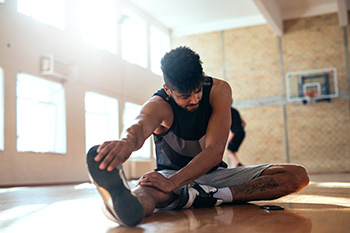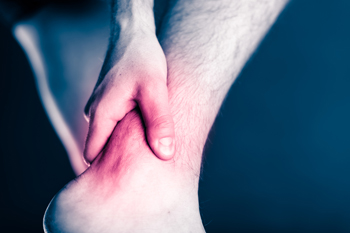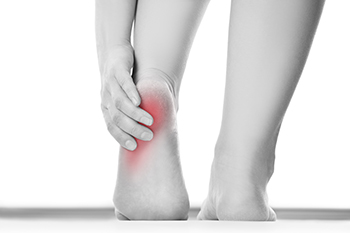July 2024
Cracked Heels and Their Effects
 Cracked heels, medically known as keratoderma, is a condition where the skin on the heels becomes thick, dry, and eventually splits. This often painful issue arises from prolonged pressure on the feet, leading to hard, callused skin that can fissure. Causes include standing for long periods, wearing open-backed shoes, and exposure to dry, cold weather. Medical conditions like diabetes and hypothyroidism also contribute by causing excessively dry skin. Excessive weight increases pressure on the heel pads, further worsening the problem. Preventing keratoderma involves regular moisturizing, wearing supportive, closed-back footwear, and avoiding prolonged standing on hard surfaces. Proper foot care routines, including gentle exfoliation and hydration, are essential to maintain soft, healthy skin and prevent the discomfort associated with cracked heels. This condition can be painful. If this applies to you, it is suggested that you visit a podiatrist who can effectively treat cracked heels, which often includes prescribed medication.
Cracked heels, medically known as keratoderma, is a condition where the skin on the heels becomes thick, dry, and eventually splits. This often painful issue arises from prolonged pressure on the feet, leading to hard, callused skin that can fissure. Causes include standing for long periods, wearing open-backed shoes, and exposure to dry, cold weather. Medical conditions like diabetes and hypothyroidism also contribute by causing excessively dry skin. Excessive weight increases pressure on the heel pads, further worsening the problem. Preventing keratoderma involves regular moisturizing, wearing supportive, closed-back footwear, and avoiding prolonged standing on hard surfaces. Proper foot care routines, including gentle exfoliation and hydration, are essential to maintain soft, healthy skin and prevent the discomfort associated with cracked heels. This condition can be painful. If this applies to you, it is suggested that you visit a podiatrist who can effectively treat cracked heels, which often includes prescribed medication.
Cracked heels are unsightly and can cause further damage to your shoes and feet. If you have any concerns, contact John Horlebein, DPM from Northern Cascades Foot & Ankle, LLC. Our doctor can provide the care you need to keep you pain-free and on your feet.
Cracked Heels
Cracked heels appear unappealing and can make it harder for you walk around in sandals. Aside from looking unpleasant, cracked heels can also tear stockings, socks, and wear out your shoes. There are several methods to help restore a cracked heel and prevent further damage.
How Do You Get Them?
Dry skin is the number one culprit in creating cracked heels. Many athletes, walkers, joggers, and even swimmers suffer from cracked heels. Age and skin oil production play a role to getting cracked heels as well.
Promote Healing
Over the counter medicines can help, especially for those that need instant relief or who suffer from chronic dry feet.
Wear Socks – Wearing socks with medicated creams helps lock in moisture.
Moisturizers – Applying both day and night will help alleviate dryness which causes cracking.
Pumice Stones – These exfoliate and remove dead skin, which allows for smoother moisturizer application and better absorption into the skin.
Change in Diet
Eating healthy with a well-balanced diet will give the skin a fresh and radiant look. Your body responds to the kinds of food you ingest. Omega-3 fatty acids and zinc supplements can also revitalize skin tissue.
Most importantly, seek professional help if unsure how to proceed in treating cracked heels. A podiatrist will help you with any questions or information needed.
If you have any questions, please feel free to contact our office located in Chelan, WA . We offer the newest diagnostic and treatment technologies for all your foot care needs.
How Stretching the Feet Keeps Them Healthy
 Keeping feet in top shape involves regular exercises and stretches that enhance flexibility, strength, and overall health, reducing the risk of injuries. Limbering up with a foot roll using a tennis ball helps massage and loosen the bottom of the foot. The bottom of the foot stretch, where you pull back on the toes while sitting, targets the plantar fascia, easing tension and preventing conditions like plantar fasciitis. The top-of-the-foot stretch is achieved by pointing the toes and gently pressing down, helping to alleviate tension and improve flexibility in the extensor muscles. Calf and Achilles stretches, such as leaning into a wall with one leg extended back, enhance the flexibility and strength of the calf muscles and Achilles tendon, essential for maintaining proper foot mechanics. The seated hamstring stretch, where you reach for your toes while seated, supports the overall flexibility of the leg, reducing strain on the feet. If you would like personalized advice on foot stretches and to address any foot concerns you may have, it is suggested that you consult a podiatrist.
Keeping feet in top shape involves regular exercises and stretches that enhance flexibility, strength, and overall health, reducing the risk of injuries. Limbering up with a foot roll using a tennis ball helps massage and loosen the bottom of the foot. The bottom of the foot stretch, where you pull back on the toes while sitting, targets the plantar fascia, easing tension and preventing conditions like plantar fasciitis. The top-of-the-foot stretch is achieved by pointing the toes and gently pressing down, helping to alleviate tension and improve flexibility in the extensor muscles. Calf and Achilles stretches, such as leaning into a wall with one leg extended back, enhance the flexibility and strength of the calf muscles and Achilles tendon, essential for maintaining proper foot mechanics. The seated hamstring stretch, where you reach for your toes while seated, supports the overall flexibility of the leg, reducing strain on the feet. If you would like personalized advice on foot stretches and to address any foot concerns you may have, it is suggested that you consult a podiatrist.
Stretching the feet is a great way to prevent injuries. If you have any concerns with your feet consult with John Horlebein, DPM from Northern Cascades Foot & Ankle, LLC. Our doctor will assess your condition and provide you with quality foot and ankle treatment.
Stretching the Feet
Being the backbone of the body, the feet carry your entire weight and can easily become overexerted, causing cramps and pain. As with any body part, stretching your feet can serve many benefits. From increasing flexibility to even providing some pain relief, be sure to give your feet a stretch from time to time. This is especially important for athletes or anyone performing aerobic exercises, but anyone experiencing foot pain or is on their feet constantly should also engage in this practice.
Great ways to stretch your feet:
- Crossing one leg over the others and carefully pull your toes back. Do 10-20 repetitions and repeat the process for each foot
- Face a wall with your arms out and hands flat against the wall. Step back with one foot and keep it flat on the floor while moving the other leg forward. Lean towards the wall until you feel a stretch. Hold for 30 seconds and perform 10 repetitions for each foot
- Be sure not to overextend or push your limbs too hard or you could risk pulling or straining your muscle
Individuals who tend to their feet by regular stretching every day should be able to minimize foot pain and prevent new problems from arising.
If you have any questions, please feel free to contact our office located in Chelan, WA . We offer the newest diagnostic and treatment technologies for all your foot care needs.
Achilles Tendon Injury Diagnosis

Diagnosing an Achilles tendon injury, such as a tear or rupture, involves several precise steps to ensure accurate identification and treatment. First, a podiatrist will discuss your symptoms, focusing on any sharp pain in the ankle or back of the leg, difficulty walking, or an audible snap at the time of injury. A thorough physical examination follows, often starting with the Thompson test, where the podiatrist will squeeze your calf muscle while you lie face down. A lack of foot movement suggests a tear. Plantar flexion tests assess your ability to flex the foot and stand on your toes. Visible signs, like a soft spot or bruising near the tendon, also may indicate damage to the Achilles tendon. Weight-bearing tests evaluate your capacity to stand on the injured foot and detect limping. For a more detailed view, imaging tests such as ultrasound or MRI may be performed. An ultrasound provides 2D images to pinpoint partial tears, while an MRI offers 3D images, which are particularly useful for identifying complete ruptures where tendon ends are detached. If you suspect an Achilles tendon injury, it's suggested that you make an immediate appointment with a podiatrist for a diagnosis and treatment.
Achilles tendon injuries need immediate attention to avoid future complications. If you have any concerns, contact John Horlebein, DPM of Northern Cascades Foot & Ankle, LLC. Our doctor can provide the care you need to keep you pain-free and on your feet.
What Is the Achilles Tendon?
The Achilles tendon is a tendon that connects the lower leg muscles and calf to the heel of the foot. It is the strongest tendon in the human body and is essential for making movement possible. Because this tendon is such an integral part of the body, any injuries to it can create immense difficulties and should immediately be presented to a doctor.
What Are the Symptoms of an Achilles Tendon Injury?
There are various types of injuries that can affect the Achilles tendon. The two most common injuries are Achilles tendinitis and ruptures of the tendon.
Achilles Tendinitis Symptoms
- Inflammation
- Dull to severe pain
- Increased blood flow to the tendon
- Thickening of the tendon
Rupture Symptoms
- Extreme pain and swelling in the foot
- Total immobility
Treatment and Prevention
Achilles tendon injuries are diagnosed by a thorough physical evaluation, which can include an MRI. Treatment involves rest, physical therapy, and in some cases, surgery. However, various preventative measures can be taken to avoid these injuries, such as:
- Thorough stretching of the tendon before and after exercise
- Strengthening exercises like calf raises, squats, leg curls, leg extensions, leg raises, lunges, and leg presses
If you have any questions please feel free to contact our office located in Chelan, WA . We offer the newest diagnostic tools and technology to treat your foot and ankle needs.
Causes and Dietary Recommendations for Gout

Gout is a type of arthritis caused by high levels of uric acid in the blood, leading to the formation of sharp crystals in the joints. The big toe is often affected, and the pain may become debilitating, some patients have difficulty in walking and completing daily activities. This condition can be triggered by factors such as genetics, obesity, and certain medical conditions. Diet plays a significant role in managing gout. Foods high in purines, such as red meat, organ meats, and certain seafood like sardines and shellfish, should be avoided as they can increase uric acid levels. Additionally, sugary beverages and alcohol, particularly beer, can exacerbate gout symptoms. On the other hand, a diet rich in low-purine foods can help manage gout effectively. These include fruits, vegetables, whole grains, and low-fat dairy products. Drinking plenty of water and maintaining a healthy weight can also help reduce uric acid levels. Individuals who have gout often experience extreme pain and discomfort, especially in their big toe. If this applies to you, it is strongly suggested that you are under the care of a podiatrist who can treat this condition, and lead you to making correct food choices.
Gout is a foot condition that requires certain treatment and care. If you are seeking treatment, contact John Horlebein, DPM from Northern Cascades Foot & Ankle, LLC. Our doctor will treat your foot and ankle needs.
What Is Gout?
Gout is a type of arthritis caused by a buildup of uric acid in the bloodstream. It often develops in the foot, especially the big toe area, although it can manifest in other parts of the body as well. Gout can make walking and standing very painful and is especially common in diabetics and the obese.
People typically get gout because of a poor diet. Genetic predisposition is also a factor. The children of parents who have had gout frequently have a chance of developing it themselves.
Gout can easily be identified by redness and inflammation of the big toe and the surrounding areas of the foot. Other symptoms include extreme fatigue, joint pain, and running high fevers. Sometimes corticosteroid drugs can be prescribed to treat gout, but the best way to combat this disease is to get more exercise and eat a better diet.
If you have any questions please feel free to contact our office located in Chelan, WA . We offer the newest diagnostic and treatment technologies for all your foot and ankle needs.
Do Your Child's Feet Hurt?
Quality of Life and Heel Pain
 Plantar heel pain, often caused by plantar fasciitis, can significantly impact quality of life. This condition occurs when the thick band of tissue running along the bottom of the foot becomes inflamed, typically due to overuse or strain. The resulting pain can make walking and standing difficult, limiting daily activities and reducing overall mobility. Factors such as wearing poor footwear, obesity, and prolonged standing contribute to this issue. To alleviate plantar heel pain, several measures can be taken. Wearing supportive shoes with proper arch support and cushioning is vital. Stretching exercises for the calf and foot can help relieve tension in the plantar fascia. Taking pain relievers can reduce inflammation and discomfort. In severe cases, custom orthotics may be necessary. If you have persistent heel pain, it is suggested that you schedule an appointment with a podiatrist for effective treatment and long-term relief.
Plantar heel pain, often caused by plantar fasciitis, can significantly impact quality of life. This condition occurs when the thick band of tissue running along the bottom of the foot becomes inflamed, typically due to overuse or strain. The resulting pain can make walking and standing difficult, limiting daily activities and reducing overall mobility. Factors such as wearing poor footwear, obesity, and prolonged standing contribute to this issue. To alleviate plantar heel pain, several measures can be taken. Wearing supportive shoes with proper arch support and cushioning is vital. Stretching exercises for the calf and foot can help relieve tension in the plantar fascia. Taking pain relievers can reduce inflammation and discomfort. In severe cases, custom orthotics may be necessary. If you have persistent heel pain, it is suggested that you schedule an appointment with a podiatrist for effective treatment and long-term relief.
Many people suffer from bouts of heel pain. For more information, contact John Horlebein, DPM of Northern Cascades Foot & Ankle, LLC. Our doctor can provide the care you need to keep you pain-free and on your feet.
Causes of Heel Pain
Heel pain is often associated with plantar fasciitis. The plantar fascia is a band of tissues that extends along the bottom of the foot. A rip or tear in this ligament can cause inflammation of the tissue.
Achilles tendonitis is another cause of heel pain. Inflammation of the Achilles tendon will cause pain from fractures and muscle tearing. Lack of flexibility is also another symptom.
Heel spurs are another cause of pain. When the tissues of the plantar fascia undergo a great deal of stress, it can lead to ligament separation from the heel bone, causing heel spurs.
Why Might Heel Pain Occur?
- Wearing ill-fitting shoes
- Wearing non-supportive shoes
- Weight change
- Excessive running
Treatments
Heel pain should be treated as soon as possible for immediate results. Keeping your feet in a stress-free environment will help. If you suffer from Achilles tendonitis or plantar fasciitis, applying ice will reduce the swelling. Stretching before an exercise like running will help the muscles. Using all these tips will help make heel pain a condition of the past.
If you have any questions please contact our office located in Chelan, WA . We offer the newest diagnostic and treatment technologies for all your foot and ankle needs.







